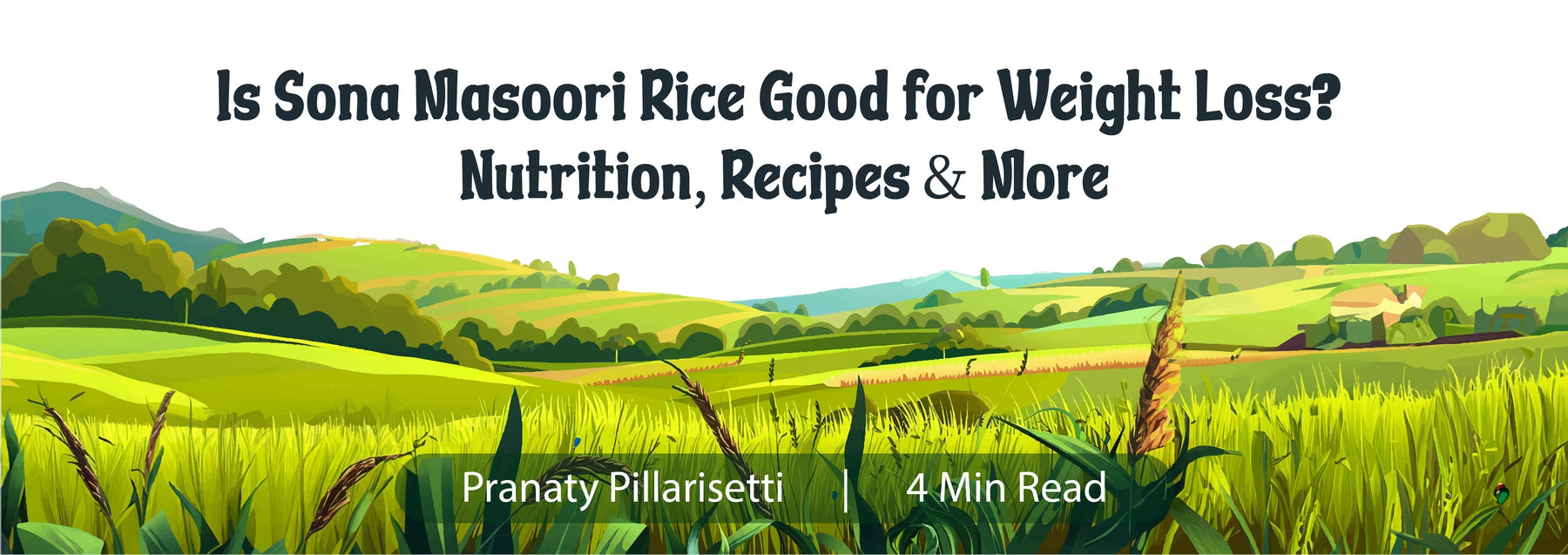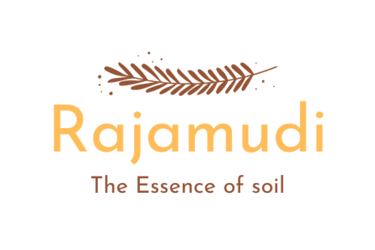
Is Sona Masoori Rice Good for Weight Loss? Nutrition, Recipes & More
The Rice that feels like Home
It's been a long, busy day. You just want something warm, comforting, and familiar. You walk into the kitchen and see it: a steaming bowl of dal chawal. That first bite? Just pure relief. For a lot of us, especially in South India, rice is a memory, a feeling, and a source of comfort all at once.
It's the heart of South Indian kitchens. You can ask any family in Andhra Pradesh, Telangana, Karnataka, or Tamil Nadu, and they'll tell you that a meal isn't complete without Sona Masoori or Sona Masuri. Because of its soft texture and mild smell, it has become the rice of choice for everyday meals, holiday meals, and comfort food. But what makes it so special? Why are more people seeing it as a healthier choice, even for losing weight?
As the demand for this staple grew over the years, the way commercial farms worked started to change. Hybrid seeds, chemical fertilisers, and pesticides came into the picture to make the grain grow faster, produce more, and make more money. The original heirloom Sona Masoori, which grew slowly, smelt good naturally, and was easy on the stomach, began to disappear from stores. The version that most people eat now is very different from the original.
We at Rajamudi Organics are committed to reviving the original grain. On our own organic-certified farms in Andhra Pradesh and Karnataka, we grow our Sona Masoori the old-fashioned way, devoid of synthetic chemicals, genetically modified organisms, pesticides, and, most importantly, a regenerative grain. Our grandparents loved, treasured, and believed that this rice was good for the body and the soul. Selecting this type entails making thoughtful, health-conscious food choices while re-establishing a connection with one's heritage.

Why Organic Sona Masoori?
For many, rice is comfort. After a long day, slipping into something familiar like a warm plate of dal and rice is all that’s needed to unwind. The lightly cooked grains offer not just satiety but warmth and ease. Its low starch content makes it fluffy rather than sticky, easy to digest, and gentle on the gut. Whether paired with sambar, rasam, curd, or pickles, it complements flavors without overpowering them.
It's amazing how this one grain has spread throughout different regions, going by different names like Jeela Karra Masuri, Bangaru Theealu, Samba Masuri, and Masuri Rice, but it's still adored everywhere. Sona Masoori's prominent appearance in celebratory platters, daily lunchboxes, and festive menus is not surprising.
Beyond tradition, however, people are becoming more conscious of the impact that our diet has on our health. Here, Sona Masoori's standing as a diet-friendly rice has drawn notice, albeit with some controversy.
Can Sona Masoori Help with Weight Loss?
The answer isn’t straightforward, but let’s unravel it.
By itself, rice contains carbohydrates, which are the body's main source of energy. However, not all carbohydrates are made equal. Sona Masoori is a better option for people attempting to control their calorie intake without compromising fullness because it has less starch than other polished white rice varieties. Because of its fibre content, which aids in digestion and delays the absorption of glucose, energy levels remain steady throughout the day.
It can help with gradual, long-term weight management when included in a balanced diet with vegetables, lentils, and other proteins. Although Sona Masoori is not a miracle food, it is far better than highly processed grains that cause insulin levels to rise rapidly when consumed in moderation and with wholesome accompaniments.
Additionally, because it is light and easy on the stomach, it is perfect for pregnant women, people recovering from illness, and even fitness enthusiasts who need nourishing meals without feeling sluggish.

The Commercialization of Sona Masoori: What Changed?
As cities grew and populations increased, so did the demand for rice. Higher yield techniques were adopted in agricultural practices to satisfy this demand, frequently at the expense of environmental health, flavor, and nutrition.
By concentrating on faster-growing varieties that could be mass-produced, hybridisation changed the genetic composition. Although chemical pesticides and fertilisers increased productivity, they also left residues in the soil and water. Under pressure to reach targets, farmers increasingly turned to practices that increased profits at the expense of quality. Many customers subsequently, by accident, became accustomed to a Sona Masoori that lacked the mild scent, fluffy texture, and digestibility that once characterised it.
Choosing a regenerative, organic, slow-grown Sona Masoori brings back the real deal that commercial farming diluted. At Rajamudi Organics, every grain we offer tells a story of farmers returning to age-old methods that respect nature’s rhythm.
Bringing Back the Real Grain: Regenerative Farming with Rajamudi
At Rajamudi Organics, we’ve taken a conscious step to reverse this trend of commercial variety by working closely with farmers to revive the authentic, heirloom Sona Masoori through regenerative and organic farming methods.
What does natural or organic farming actually mean, then? It's about returning to how plants are naturally grown in forests, which is by cultivating crops without the use of artificial fertilizers, pesticides, or genetic engineering and instead emphasizing the development of healthy soil, water conservation, and biodiversity preservation. Organic farming preserves the grain's natural flavor and nutrients while restoring ecosystems by enriching rather than depleting the land. What does the term "regenerative" mean? It indicates that the grain will be able to grow again for the following harvest. The majority of the grains we currently consume are not sustainable for the environment because they cannot develop into entirely new plants.
The environment, humans, and the rice itself all greatly benefit from the natural farming method. While organic methods preserve water sources and improve the soil for upcoming harvests, the lack of chemicals means that our food contains fewer dangerous residues. Additionally, consuming food produced in this manner promotes general health by enhancing immunity, energy levels, and digestion without the use of dangerous additives.

Important minerals like iron and magnesium, as well as moderate protein and carbohydrates, are all present in our heirloom Organic Sona Masoori. Its low starch content makes it easier on the stomach and enhances glucose absorption and long-lasting energy, making it the ideal choice for anyone looking for healthy, nutritious foods, including new mothers and those who are trying to lose weight.
But heirloom Sona Masoori is just one of the gems we offer. We also grow other tried-and-true varieties at Rajamudi, including Diabetic Rice, Navara, Indrayani, and Rajamudi our signature variety). These grains were chosen for their taste as well as their health advantages, whether you're trying to control your diabetes, lose weight, or just want easily digestible, high-fiber meals that complement your regular diet.
When combined, these ancient grains provide a route to mindful eating, where wellness, tradition, and deliciousness all coexist. Not only are you feeding yourself when you choose organic, regenerative rice varieties, but you're also helping to support sustainable farming methods that take care of the environment and the people who grow our food.
How to Choose Quality Rice?
Today's Sona Masoori rice isn't all made alike. To save money, commercially produced forms are frequently over-polished or combined with broken grains, which detracts from their flavor and nutritional value. Whole, slightly off-white grains with a natural scent are characteristics of high-quality rice. Excessive processing is indicated by an artificial appearance or excessive brightness. Selecting rice from reliable suppliers who make reference to organic, heirloom, or regenerative farming ensures that the grains are nutrient-dense and produced without the use of harmful substances. Its freshness, texture, and flavor are preserved when stored in airtight containers, making every meal feel as wholesome and comforting as it should.
How to cook Sona Masoori?
Fortunately, there is nothing new for you to learn! Simply prepare it as you normally would. If you want softer grains, simply rinse it a few times and soak it for 20 to 30 minutes. Regardless of whether you're cooking in a microwave, an open pot, or a pressure cooker, Rajamudi Organics advises using two cups of water for every cup of rice. Feel free to change the water ratio, though, depending on your preferred rice texture. Light, fluffy grains that are excellent at absorbing flavors are the end result.
Some recipes to try:
These dishes highlight how versatile Sona Masoori is from simple meals to elaborate spreads bothe savory and sweet.
Choosing the appropriate type, such as our organic, heritage Sona Masoori, entails making a thoughtful decision for the environment, your family, and your health. It's about enjoying each bite with confidence knowing that the grains you cook are healthy, nutritious, and meticulously grown. Alongside Sona Masoori, varieties like Rajamudi, Navara, Indrayani, Diabetic Rice, and more offer numerous options for those looking for fibre-rich, easily digestible, and diabetes-friendly meals.
So, whether you’re cooking a simple lunch or preparing a feast, choosing traditional grains helps you stay connected to the roots of good food while supporting sustainable farming practices. It’s a small step that makes a big difference for your body, your taste buds, and the earth.

